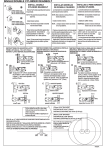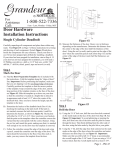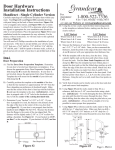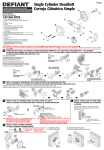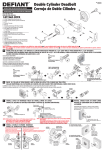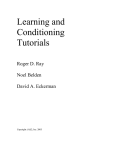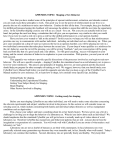Download Nostalgic Warehouse NEW-62-VB-KA Instructions / Assembly
Transcript
������������ For Assistance Call: ���� �� 1-800-522-7336 ���� �� ���� �� ���������� 8 am - 5 pm, Monday - Friday, MST Door Hardware Installation Instructions ��� Double Cylinder Deadbolt Carefully unpackage all components and place them within easy reach. Find Figure #1 on Page 5 of these instructions for a listing and drawing of each component. Detach Figure #1 and place beside the components for easy reference. Check your door to see if it has been prepped (pre-drilled) for installing a deadbolt. If your door has been prepped for installation, start at Step 4. If your door has not been prepped for installation, you will need a #2 Phillips screwdriver, a drill, a 2-1/8” hole saw, 7/64” drill bit, 1” drill bit, chisel, pencil, tape and an awl (or nail). Figure #2 D) Measure the thickness of the door. Doors vary in thickness depending on the manufacturer. Determine the distance from the center to the edge of the door (half the thickness of the door). Using the awl (or nail), mark a point on the edge of the door where the centerline pencil mark (from Step 1C) and the center of the edge of the door meet (half the thickness), see Figure #3. ������������������ ������ ������� Step 1 Mark the Door A) Find the Door Preparation Template which is included with the instructions. Fold the template along the “edge-of-door” line. Important: Before positioning the template, make sure that you are aligning it on the non-hinged edge of the door. Carefully position the template so that the narrow portion of the template wraps around the edge of the door, and the large portion of the template remains on the face of the door, see Figure #2. Slide the template up or down on your door so that the centerline is located at a height that is both comfortable to use and attractive in appearance. Typically, this will be approximately 36”-38” from the floor, see Figure #2. Once you have chosen the height, tape the template to the door. B) Determine the backset of the deadbolt latch (Part #1) by checking the marking on the deadbolt latch itself. If the latch is not marked, measure the latch between points A and B to determine the backset, as shown in Figure #2. The backset will either be 2-3/8” or 2-3/4”. Once you know your backset, find the point on the template where the centerline crosses the vertical line that corresponds with the correct backset. Using the awl (or nail) mark this point, making sure that it is marked well enough to see on the door once the template is removed. C) Follow the centerline around the edge of the door and using a pencil, extend the centerline onto the edge of the door. The mark should be horizontal to the floor. Once this mark is made, you may remove the template from the door. ��� ����������� �������������� �������� ���������� ������� ��������� ��������� �������� ���������� ������� ���������� �������� ����������������� ������������� ����������� ��������� ������� ������ ������������������ Step 2 Drill the Door ���������� ������� ��������� ������� ���� �������������� Figure #3 A) Using the 2-1/8” hole saw, drill the cross bore hole centered on the mark made on the face of the door from Step 1B. See Figure #3. Important: To avoid splintering or marring the door, drill from one side of the door until the pilot bit just barely comes through the door. Then finish drilling from the other side of the door, using the hole made by the pilot bit as your guide. B) Using the 1” bit, drill the edge bore hole centered on the mark made on the edge of the door where the centerline and center thickness met from Step 1D, see Figure #3. Important: Make sure that you drill a full 3-1/2” deep, to accommodate the overall length of the 2-3/8” latch. If you are using a 2-3/4” backset latch, then the overall depth must be at least 3-3/4”. Page 1 - PK158 Step 3 Step 5 - Install the Deadbolt Mortise for the Faceplate “Outside” Half A) Using Figure #1 for reference, find the deadbolt faceplate (Part #2). On the edge of the door, center the deadbolt faceplate over the newly drilled edge bore hole, so that the large hole in the deadbolt faceplate is centered over the 1” edge bore hole. Align it so that the edges are parallel to the edges of the door and roughly centered side-to-side. Mark around the deadbolt faceplate with a pencil and remove from door. A) Using Figure #1 for reference, gather together both cylinder assemblies (Part #4 & #6), both spin rings (Parts #5A), both deadbolt escutcheons (Parts #5B), security ring (Part #16) and 2-3/4” machine screws (Part #7). Note: Not all designs use spin rings. If your escutcheon is a Newport or Georgetown design, then no spin ring is required. Except in rare cases such as split finish designs, the interior and exterior escutcheons will be interchangeable. B) Using the chisel, score the outline of the deadbolt faceplate. Next, chisel away the material within the outline to a depth of 1/8”. When you are done, you should be able to insert the deadbolt latch (Part #1), place the deadbolt faceplate over the extended deadbolt (Part #1A), and have the deadbolt faceplate be flush with the edge of the door. C) Again, using the deadbolt faceplate as a template and the awl as a marking tool, mark for the two screw holes that will hold the deadbolt faceplate on the door. Remove the deadbolt faceplate from the door to avoid marring the finish. Then, drill the two screw holes using a 7/64” drill bit. Make sure the holes are drilled at least 1” deep. Having too shallow a hole can cause the screws to shear off. Installing Your Lock Step 4 Install the Latch A) Insert a screwdriver into the deadbolt latch housing (Part #1) and extend the deadbolt. Insert the deadbolt latch into the edge bore hole, making sure that the “+” is oriented towards the lower edge or bottom side of the deadbolt latch, see Figure #4. �������������� ��������� ��������� �������� ���������� Interior Cylinder Figure #5 Exterior Cylinder B) Locate the exterior cylinder assembly, see Figure #5. This can easily be identified by the Grandeur logo on it. Note: If your design requires a spin ring, place the cylinder bar (Part #4A) end of the cylinder assembly (Part #4) through the spin ring, making sure that the narrower diameter of the spin ring is closest to the key hole end of the cylinder assembly. Next, insert the cylinder assembly (with spin ring if required) through the deadbolt escutcheon (Part #5B) and finally add the security ring as seen in Figure #6. ��������� ���� ���������� �������� ���������� ���������� ������������ ���������� �������� ��������� ��������� ��������� �������� ��������� ��������� ���������� ������������������� ������������ ��������� ���������� ���� �������������������� ���������� Figure #4 B) Add the deadbolt faceplate over the deadbolt latch and make sure that it can sit flush in the mortised out area. Note: Some doors come prepared with rounded corners in the mortisedout area. If your door is prepared like this, simply use a chisel to square off the corners so that the faceplate lies flush with the edge of the door. C) Install the 3/4” latch & strike wood screws (Part #3) to hold the deadbolt latch and deadbolt faceplate in place. Figure #6 C) From the outside of the door, insert the cylinder bar (Part #4A) through the “+” in the deadbolt latch housing. Make sure that the cylinder bar is oriented as shown in Figure #7A or Figure #7B and that the deadbolt is still extended from the edge of the door. From the inside of the door, if the deadbolt extends toward the right, then the cylinder bar needs to be oriented vertically Figure #7A. If the deadbolt extends toward the left, then the cylinder bar needs to be oriented horizontally, Figure #7B. IMPORTANT: If this step is not done correctly, then the deadbolt will not work correctly! Page 2 - PK158 Inside of Door Deadbolt extends right Inside of Door Deadbolt extends left I) Figure #7A Figure #7B D) Make sure that the cross bore hole will be completely covered by the outside escutcheon and that the Grandeur logo is oriented correctly. “Inside” Half E) Locate the interior cylinder assembly (Part #6). This can easily be identified because it has two holes drilled through the face of the cylinder, see Figure #5. Assemble the interior cylinder assembly and escutcheon as outlined in Step 5B. F) Rotate the interior cylinder bar so that it is oriented in the opposite orientation that you used in Step 5C. Holding the exterior half of the deadbolt on the door, install the interior half of the deadbolt. The driver bars will mate together in the hub of the deadbolt latch. Depending on the thickness of your door, the interior and exterior should be able to sit flush against the door. If they do, go to Step 5I. G) Adjustments must be made for thinner doors where the deadbolt cannot sit flush against the door. Remove the interior half of the deadbolt and set it aside. Holding the exterior half in place, observe how much of the cylinder driver bar (Part #4A) sticks through the latch, see Figure #7A & #7B. The tangs on the driver bar are scored with marks to make this easier. Count the marks showing through on a single tang and if desired, mark the tang using a marker. Remove the exterior half of the deadbolt. Using wire cutters, carefully snip off the tangs at the last mark that was visible when it was installed through the latch, being careful not to bend the tangs. Reinstall the exterior half of the deadbolt to verify that the tangs have been cut to the length which only leaves a small amount still protruding from the latch. Follow these same steps for the inside cylinder assembly. H) Reinstall the deadbolt parts as outlined in Steps 5C - 5F. The spin ring (or round escutcheon for Newport and Georgetown designs) on the inside of the door, must be oriented with the escutcheon slots at the 1 o’clock, 5 o’clock, 7 o’clock and 11 o’clock positions, a shown in Figure #8. Locate the two 2-3/4” machine screws (Part #7). While holding both the interior and exterior halves in place, insert the machine screws through the interior cylinder assembly. The screws will go through the latch and into the back of the exterior cylinder assembly. Slowly screw in the machine screws until nearly snug. Align the escutcheons for appearance and fully tighten the screws. J) Insert, turn, and remove the key in each side to make sure that the deadbolt operates smoothly. If not, loosen the screws and realign the escutcheons. With the screws not fully tightened, turn the key on each side of the door to determine if both sides operate smoothly. If only one side operates smoothly, it is likely that the cylinder assembly driver bar tangs are too long coming from the other side and are rubbing on the back of the cylinder assembly. Using the wire cutters, trim them back slightly and see if this fixes the issue. If not, call or customer service department at 800-522-7336 for assistance. K) Once you have tested the action of the deadbolt and it is acceptable, move on to Step 6. Step 6 Install the Interior Cylinder Faceplate IMPORTANT: Before moving on to Step 6 it is critical that you verify that the deadbolt is working properly. Insert the key and turn it to both the locked and unlocked position and remove the key in each position. Then repeat this for the opposite side of the door. Only once you are satisfied with the smooth operation of the deadbolt should you proceed. A) Locate the interior cylinder faceplate (Part #8) and the plastic faceplate jig (Part #9). Place the faceplate on the interior cylinder, such that the logo and hole for the key align with the cylinder. There are slots cut into the spin ring or escutcheon that the tabs on the edge of the faceplate will align with, see Figure #8. B) Once the faceplate is aligned correctly, place the plastic faceplate jig over the faceplate and press the faceplate into position. Important: The faceplate must be pressed into place evenly in order to avoid bending the faceplate. In most cases, you will need to lightly tap the faceplate jig with a rubber mallet or hammer to seat the faceplate properly. Step 7 Installing the Door Reinforcer and Strike Note: If door jamb is already drilled, go to Step 7E below. ���������� ������ Figure #8 A) With the deadbolt in the unlocked position, close the door. From the inside of the house, turn the key and identify where the bolt is contacting the door jamb. Lightly mark this with a pencil on the door jamb. Measuring in from the door stop trim, identify the center mark where the bolt hole needs to Page 3 - PK158 be drilled. Hint: If you cannot see the bolt clearly, or cannot mark the jamb with a pencil because the door is closed, you can cover the end of the bolt with a light amount of lipstick or similarly visible material. When you turn the key, the lipstick will mark the door jamb. �������� ���������� ���������� ���������� ���������� ����� ����� ���� ������������ ���������� �������������� ���������� ��������������������� ����������� ��������� Figure #9 B) Using a 7/8” drill bit, drill two holes centered 5/16” above and below the center mark. These holes will overlap. Make sure each one is at least 1-1/8” deep. C) Clean out the hole (if needed) and insert the black dust box (Part #10). Close the door carefully, making sure not to crush the dust box. Make sure that the deadbolt and dust box line up. If not, carefully enlarge the hole as needed. D) Using the strike plate (Part #13), mark the area to be mortised out for the dust box (Part #10), door frame reinforcer (Part #11), and strike plate. Use a chisel to mortise this area and make sure that once assembled, the strike plate sits flush to the door jamb. E) Place the door frame reinforcer over the dust box. Using the door frame reinforcer as a guide, find the holes closest to the outside of the house and drill two 7/64” x 3” deep holes for the reinforcer screws. F) Install the 3” wood screws (Part #12). Again, check to make sure the deadbolt and reinforcer line up and that the deadbolt can be locked. G) Drill two 7/64” x 3/4” deep holes for the strike plate and install the strike plate using the 3/4” latch and strike wood screws (Part #3). Congratulations! You are now on your way to enriching your life with ! Page 4 - PK158 ��������� ���������� ����������� ���������� ���������� ������������ ���������� �������� ���������� �������������� ���������� ������������� ������������ ������ ���������� �������� ���������� ���������� ������������ ���������� ��������� �������� �������� ��������� �������� ��������� ��������� �������� ���������� �������������� ��������� ������������� ���������� Figure #1 ��������� �������� �������� ��������� �������� ��������� ��� ��������� Page 5 - PK158 ������ ������� ������ ��������� �������� �������� ��������� ��������� �������� ���������� ���������� ��������� ����������






